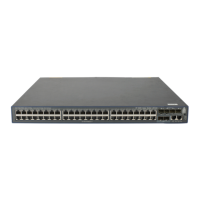48
Ste
Command
Remarks
1. Enter system view. system-view N/A
2. Create a NAS ID profile and
enter NAS ID profile view.
aaa nas-id profile profile-name
You can apply a NAS ID profile to
an interface enabled with portal.
See "Configuring portal
authentication."
3. Configure a NAS ID-VLAN
binding.
nas-id nas-identifier bind vlan
vlan-id
By default, no NAS ID-VLAN
binding exists.
Specifying the device ID used in stateful failover
mode
Two switches working in stateful failover mode for portal services are uniquely identified by their device
IDs. A device ID can only be 1 or 2. For more information about the stateful failover mode for portal
services, see "Configuring portal authentication."
Follow these guidelines when you specify the device ID used in stateful failover mode:
• Configuring or changing the device ID of a switch logs out all online users of the switch.
• HP recommends to save the configuration and reboot the switch after configuring or changing the
device ID.
• The device ID is the symbol for stateful failover mode. Do not configure any device ID for a switch
working in stand-alone mode.
To specify the device ID used in stateful failover mode:
Step Command Remarks
1. Enter system view.
system-view N/A
2. Specify the device ID used
in stateful failover mode.
nas device-id device-id
By default, a switch works in standalone
mode and has no device ID.
Configuring a switch as a RADIUS server
RADIUS server functions configuration task list
Task Remarks
Configuring a RADIUS user Required
Specifying a RADIUS client Required
Configuring a RADIUS user
This task is to create a RADIUS user and configure a set of attributes for the user on a switch that serves
as the RADIUS server. The user attributes include the password, authorization attribute, expiration time,

